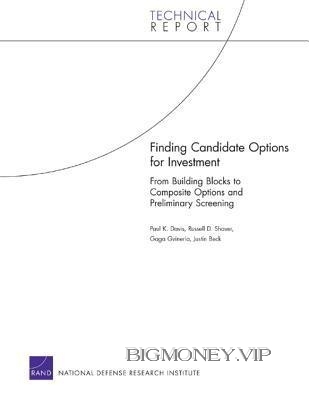Finding Candidate Options for Investment: From Building Blocks to Composite Options and Preliminary Screening by Paul K. Davis

1
CHAPTER ONE
INTRODUCTION
The Department of Defense has considerable interest in examining investment programs
by capability area. A common problem in doing so for a given capability area is that many of
the options that arise for consideration come from different people and organizations and were
developed based on the organizations’ past efforts, knowledge, and interests. The possible
options thus reflect diverse assumptions about what capabilities are needed. Only sometimes
have the individuals involved thought much about opportunities for synergy, either across
Services or across capability areas, except where doing so is natural for their particular interests
(e.g., an airplane builder seeing multiple missions). Further, only sometimes do those individuals
offer up variants that cost and deliver more or less than what they recommend. As a result,
decisionmakers who must allocate limited resources often lack information they need for
performing tradeoff analyses, devising combined strategies that exploit synergies and hedge
against risks, and making program adjustments wisely (e.g., increasing or decreasing allotments
to various programs, relative to what is requested). Thus, there is need for a more comprehensive
and systematic approach to option-generation, not merely the evaluation of options being
proposed in the usual manner.
This report describes a methodology and a related tool, the Building Blocks to Composite
Options Tool (BCOT), for developing candidate options to be given serious consideration. It
bears on how to conceive and construct options that might not otherwise be considered and on
how to screen huge numbers of possible options so as to narrow down the set of candidates. The
report draws on some classic methods of portfolio economics and operations research but extends
them significantly with original work and application to defense planning. It illustrates the
method with a notional application.
Shaver drew on classic methods to develop a first version of the methodology using
Microsoft Excel.® Excel has many virtues, including its ubiquity and versatility, built-in graphics
capability, and menu-driven operations, such as sorting. It allows arrays to be manipulated easily
and sophisticated charts to be constructed readily. Throughout most of our effort, we relied
primarily upon the Excel version. It is the instrument of choice for some of our work. Most of
the development of BCOT was accomplished in 2006.
Davis generalized the theory and, recognizing some limitations of the Excel version,
designed and built a version of BCOT in the Analytica® modeling system, which has advantages
for some aspects of clarity, extensibility, collaboration, and exploratory analysis. Gvineria then
improved and extended the Analytica model substantially, implementing important but difficult-
to-achieve capabilities that greatly extended the capacity for multiparameter exploratory analysis.
A review of the methodology by Beck identified a number of residual problems, including
fundamental difficulties. Subsequently, as the result of a concrete illustrative application (to the
Global Strike problem) and many collaborative sessions, we improved the methodology and both
the Excel and Analytica tools considerably. The result that we describe here is the Analytica-
based version of BCOT, but we continue to use both versions, referring to BCOT and BCOT-
Excel to distinguish between them.
Chapter Two describes BCOT’s higher-level structure and flow, primarily with visual
representations. Chapter Three describes BCOT’s graphical user interface—i.e., the centralized
access point for inputs and outputs. Chapter Four illustrates cryptically a highly simplified
application to the Global Strike capability area. Chapter Five summarizes conclusions and
identifies possible next steps for development of both the methodology and BCOT. Appendices
A through H provide more detail on mathematical issues, including our use of Analytica’s
powerful array-based methods to enable exploratory analysis, and also various programming
subtleties and practical issues for users.
Appendices A and B discuss subtleties of BCOT’s mathematics. Appendix C describes a
genetic-algorithm alternative to BCOT which our colleague Paul Dreyer developed in parallel to
enable us to deal with cases in which huge numbers of BCOT composite options might
overwhelm a personal computer. This method was implemented in Visual Basic. Appendices D,
E, and F provide users with some guidance about how to make common changes in BCOT for
particular applications. Appendix G discusses BCOT’s array mathematics and its
implementation, using built-in and customized Analytica operators. Appendix H advises users on
how to produce graphics by using Excel in combination with Analytica.
BCOT is not only a prototype, it is also a living tool that will be adapted with each
application. With this continuing evolution in mind, we have sought to make BCOT self-
documenting, since built-in documentation can be kept current. This report provides an
overview, which should remain valid, and a discussion of various technical issues that will
probably remain relevant even though details of BCOT itself evolve. The user should begin by




